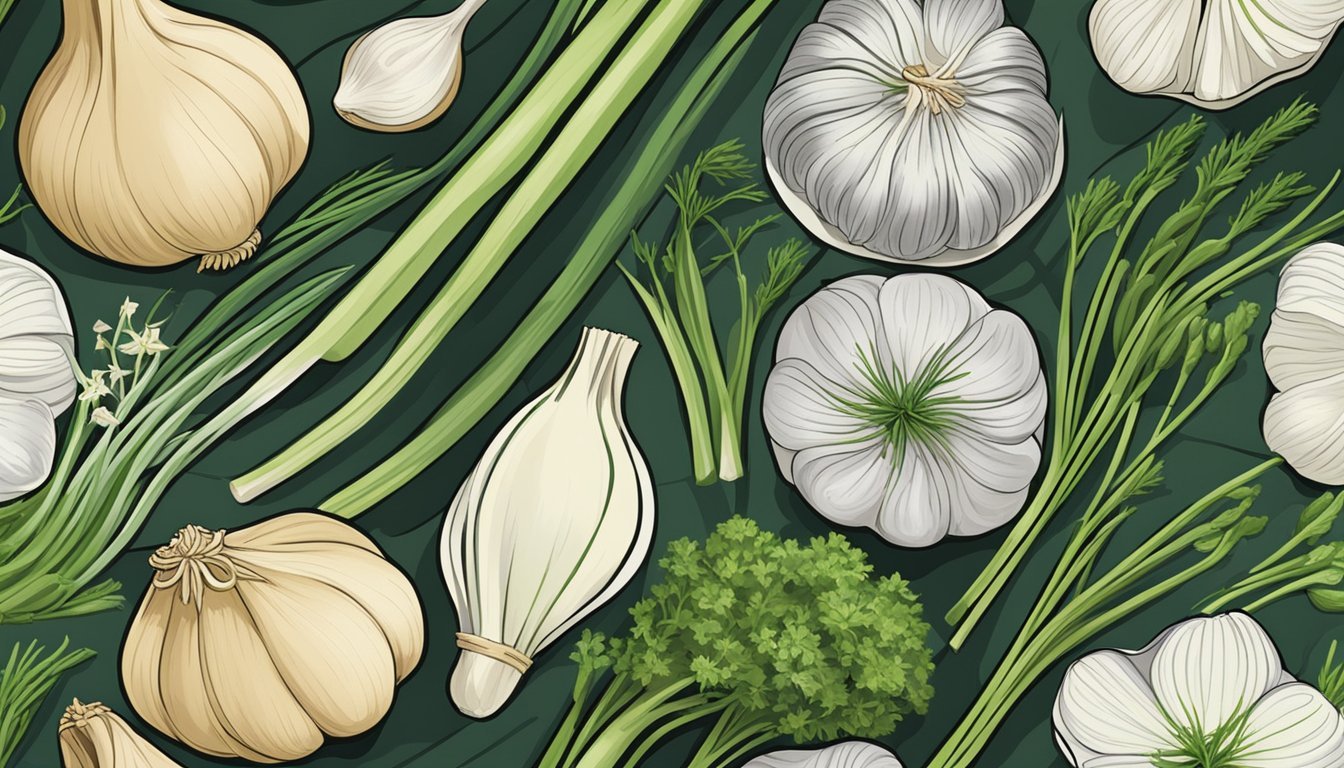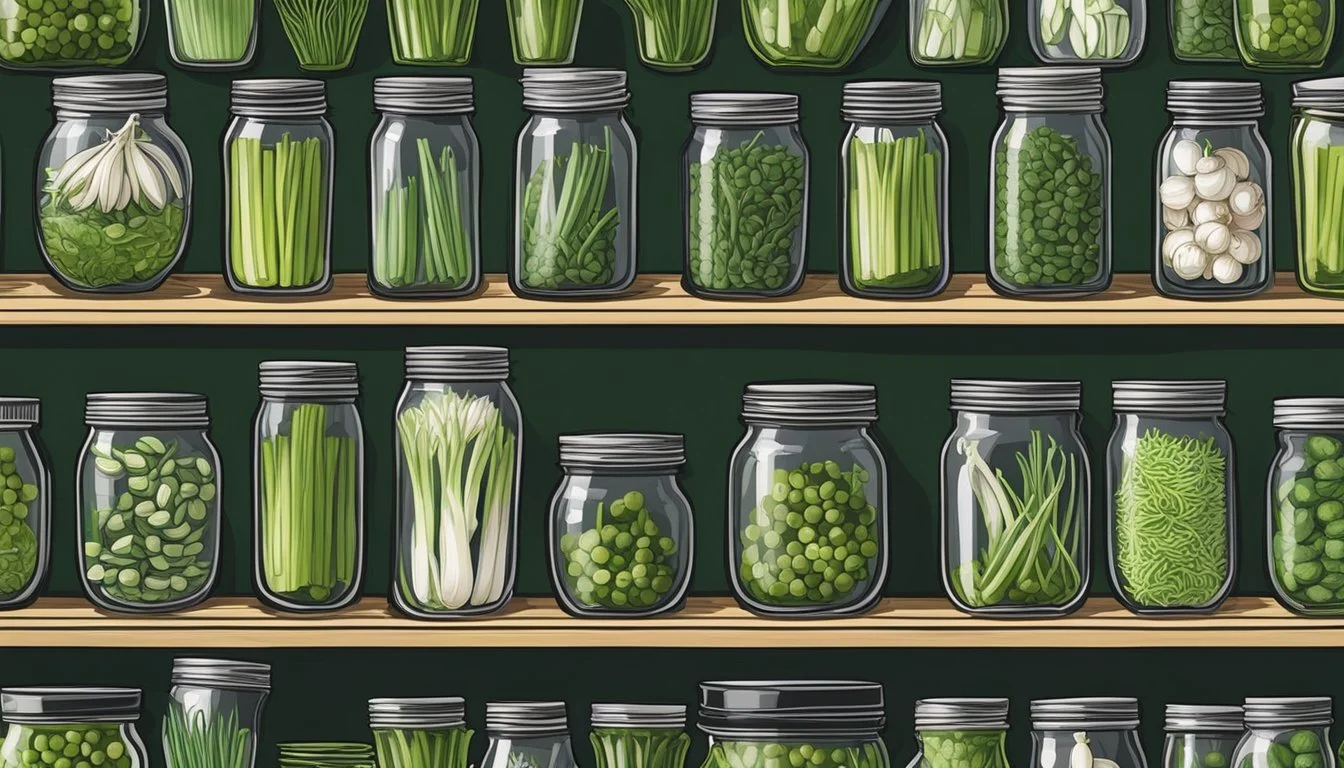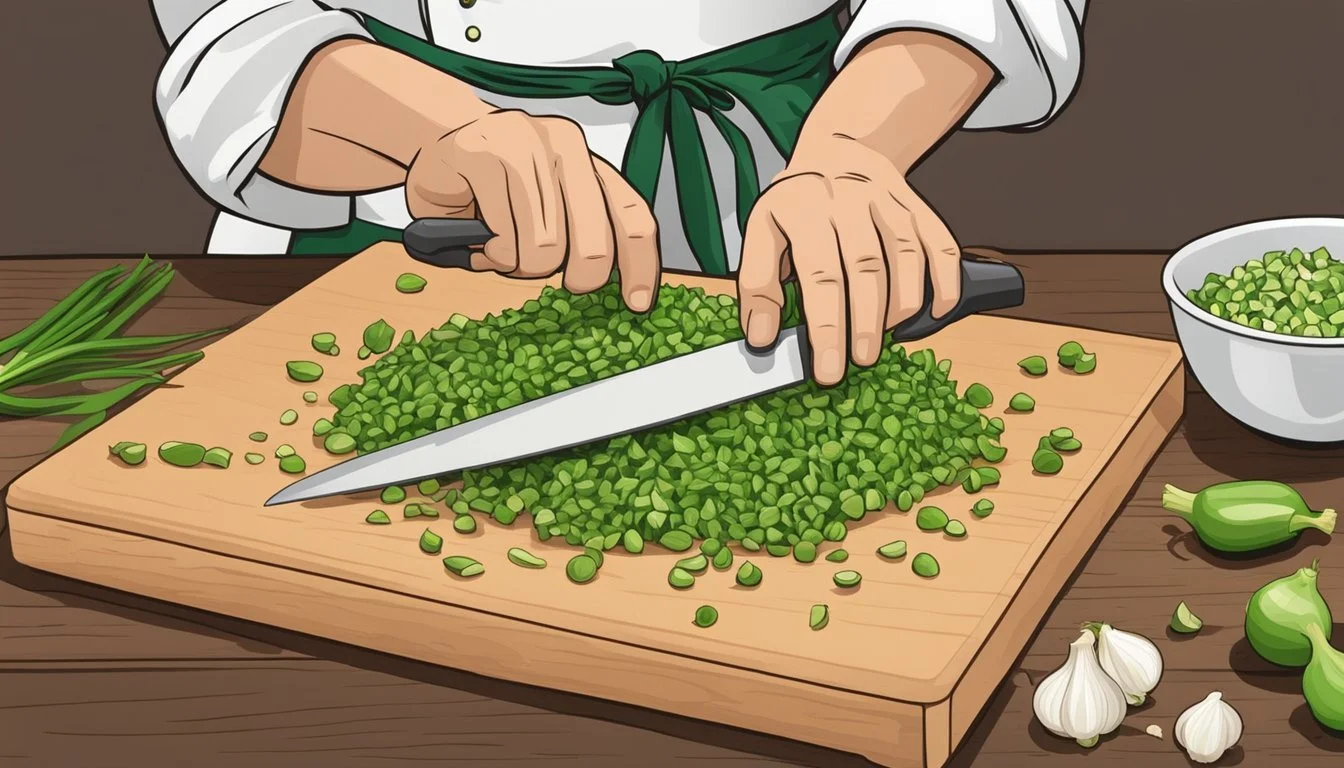Green Garlic Substitutes
Best Alternatives for Recipes
Finding substitutes for green garlic can be a game-changer in your cooking, especially when it's not readily available. Whether you're crafting a beloved recipe or experimenting with new flavors, having the right alternatives can make a significant difference. Green garlic, with its unique blend of fresh garlic and mild onion flavors, can often be replaced with more accessible ingredients.
Scallions are an excellent substitute for green garlic, offering a similar taste profile and texture. They are widely available in stores and can seamlessly integrate into your dishes, maintaining that mild onion-like flavor. Additionally, minced shallots can also serve as a good replacement, providing a slightly different but complementary taste to your meals.
For those looking to retain the garlic essence, garlic powder, minced garlic, dehydrated garlic flakes, or garlic paste can be used in specific proportions to achieve the desired flavor. These substitutes ensure that your recipes remain flavorful while accommodating the absence of green garlic.
Understanding Garlic and Its Unique Flavor Profile
Garlic holds a prominent place in culinary practices due to its intense and garlicky flavor. It belongs to the Allium family and features a distinctive composition that defines its savory taste, making it a versatile ingredient in various recipes.
Culinary Importance of Garlic
Garlic is essential in many cuisines worldwide. Its intense, garlicky flavor significantly enhances savory dishes. In its raw form, garlic is pungent and packs a powerful taste. When cooked, it mellows, providing a slightly sweet, nutty flavor.
Garlic's versatility allows it to be used in soups, marinades, dressings, and sauces. It's integral in dishes like garlic bread, aioli, and pesto. Whether minced, crushed, or roasted, garlic imparts a profound depth to any recipe it graces.
The Composition of Garlic Flavor
Garlic's unique flavor comes from its chemical composition. When garlic is chopped or crushed, the enzyme alliinase converts alliin into allicin, responsible for the characteristic garlicky taste and aroma.
This reaction is most intense when garlic is fresh. Cooking transforms these compounds, leading to a sweeter, less pungent flavor. Its savory flavor is due to sulfur compounds, which contribute to its distinct pungency and aromatic qualities. These elements make garlic a distinctive and irreplaceable ingredient in the culinary world.
Common Garlic Substitutes and Alternatives
Certain ingredients can effectively replicate the flavor profile of fresh garlic. These include various members of the onion family, dried garlic products, and other aromatic vegetables that provide a similar taste and aroma.
Onions and Shallots
Onions and shallots make excellent substitutes for garlic in many recipes. They belong to the same plant family and offer a mild, savory flavor.
Shallots have a unique blend of both onion and garlic flavors, making them a versatile option. Use 1 tablespoon of minced shallot to replace 1 clove of garlic. They work well in sauces, dressings, and sautéed dishes.
Yellow and white onions can also substitute garlic, though they provide a more pronounced sweetness. Chop the onions finely and adjust the amount according to the desired intensity. In general, 1/4 cup of chopped onion can replace 1 teaspoon of garlic.
Leeks and Scallions
Leeks and scallions are milder alternatives that impart a subtle onion-like flavor without overpowering dishes.
Leeks offer a delicate taste and are useful in soups and stews. The white and light green parts are most flavorful. Use 1/2 cup of sliced leeks to substitute 2-3 garlic cloves.
Scallions (green onions) are another option, especially for salads and fresh applications. The entire scallion, from white to dark green tips, is edible. Replace garlic with 1-2 scallions per clove for a similar touch of flavor in dishes.
Chives and Garlic Chives
Chives and garlic chives provide a mild flavor that can enhance a variety of dishes.
Chives have a subtle onion taste, making them suitable for garnishes and adding freshness to recipes. Sprinkle 1 tablespoon of chopped chives to replace 1 clove of garlic.
Garlic chives, also known as Chinese chives, offer a slightly stronger garlic aroma. These can be used in stir-fries, soups, and marinades. Use 1 tablespoon of chopped garlic chives to substitute 1 clove of garlic. Both types of chives work best when added at the end of cooking.
Garlic Powder and Granulated Garlic
Dried garlic alternatives like garlic powder and granulated garlic are convenient and have a long shelf life.
Garlic powder is made from dehydrated garlic and has a much more concentrated flavor. As a rule of thumb, 1/8 teaspoon of garlic powder can replace 1 fresh garlic clove. It dissolves easily and is great for dry rubs and seasoning mixes.
Granulated garlic is coarser and less potent than garlic powder. Use 1/4 teaspoon of granulated garlic to replace 1 clove of garlic. It can be sprinkled directly into soups, stews, and marinades for a quick garlic fix. Both forms are ideal when you need to save prep time.
Substituting Garlic in Different Types of Recipes
When substituting garlic in different recipes, understanding the dish's context ensures the alternative enhances the intended flavors. Here are practical substitutes tailored to soups, marinades, dry rubs, and salad dressings.
For Soups and Marinades
Garlic's role in soups and marinades is to impart a deep, rich flavor. For soups, green onions or chives can substitute admirably due to their mild yet aromatic profile. Chives provide a subtle onion-garlic note, enhancing broths and stocks without overpowering.
Green onions add freshness, working well in clear soups and vegetable broths. For marinades, garlic powder or onion powder are excellent choices. Their concentrated flavor infuses meats and vegetables quickly, making them perfect for marinating. Using double the amount of fresh garlic called for ensures the desired intensity.
In Dry Rubs and Seasonings
Dry rubs and seasonings rely on dry ingredients for concentrated flavor. Garlic powder is an ideal substitute here. It's easily mixed with other dry spices and herbs, ensuring even distribution on meats or vegetables.
Onion powder can also be used, often combined with paprika, salt, and pepper to mimic garlic's savory depth. For an herb-based alternative, dried oregano or thyme offer aromatic qualities that complement other seasonings well.
While Preparing Salad Dressings
In salad dressings, garlic typically provides a robust, zesty bite. To maintain this, shallots are an excellent substitute. They balance sweet and pungent flavors, creating a harmonious blend with oils and vinegars.
Fresh chives can also be used, particularly in creamy dressings, for a lighter oniony taste. Garlic-infused oil is another versatile substitute. It imparts garlic's essence without altering the dressing's texture, ideal for vinaigrettes or citrus-based mixtures.
By choosing appropriate substitutes, the intended character and depth of your dishes can be preserved, ensuring flavorful results.
Specialty Garlic Substitutes
Specialty garlic substitutes offer unique flavors and convenient options for those who can't access fresh garlic. These alternatives vary in taste, usage, and shelf life.
Garlic Oil and Garlic Paste
Garlic Oil provides a concentrated garlic flavor and is perfect for drizzling over dishes or using as a base for marinades. It combines oil and garlic cloves, making it a highly aromatic addition. Ideal for those looking for both flavor and convenience, it can be stored in the pantry for extended periods.
Garlic Paste offers a smooth texture and is often used in cooking soups, dressings, and marinades. One teaspoon of garlic paste typically substitutes one clove of fresh garlic. Its long shelf life makes it a practical choice for those who wish to maintain a well-stocked pantry.
Garlic Salt and Jarred Minced Garlic
Garlic Salt combines salt and dried garlic, providing both seasoning and garlic flavor in one. It's especially useful in dishes where additional salt is beneficial. A quick sprinkle can elevate the taste of any meal, but users should be cautious of the salt content to avoid over-seasoning.
Jarred Minced Garlic is a convenient option, pre-minced and ready to use. It saves time and effort compared to peeling and chopping fresh cloves. This substitute is usually stored in oil or water, ensuring a long shelf life. Although it may lack the vibrant flavor of fresh garlic, it is a reliable and time-saving ingredient.
Asafoetida (Hing)
Asafoetida, also known as Hing, is a strong, pungent spice that can substitute garlic in various recipes. Primarily used in Indian cuisine, a small pinch can mimic the flavor profiles of garlic and onions. It is particularly useful for those who avoid garlic for dietary reasons. Hing has a long shelf life and is typically used in powder form, making it a unique addition to a spice pantry.
Unique Garlic Substitutes in Different Cuisines
Each cuisine has its own unique way of substituting garlic to add that essential punch to dishes. The following sections explore some common alternatives used in Asian, Middle Eastern, and Western cuisines.
Asian Supermarket Finds
In Asian cuisine, various ingredients provide a similar depth of flavor to garlic. Shallots are a common choice, offering a mild sweetness and subtle garlicky undertone. Chives, with their delicate flavor, are often used in soups and seafood dishes.
Giant fennel, though less common, is found in select Asian markets and delivers a unique twist with its sweet, anise-like flavor. Ginger is another versatile substitute, especially in stir-fries, providing a spicy and aromatic quality that complements many Asian dishes.
Middle Eastern Flavors
Middle Eastern cuisine often relies on spices and herbs to replicate the robust flavor of garlic. Cumin is a staple in many dishes, providing a warm, earthy taste that enhances stews, kebabs, and rice dishes.
Giant fennel is also used here for its aromatic properties and subtle sweetness. Sumac, while not a direct substitute, brings a tangy edge to dishes, offsetting the lack of garlic while adding complexity. Fennel seeds, crushed and mixed into sauces or rubs, add both texture and a delicate licorice note.
Western Cooking Staples
In Western cooking, a variety of substitutes can mimic the flavor of garlic. Onions and shallots stand out for their similar sulfuric compounds. Chives are often sprinkled over omelets, soups, and salads, providing a fresh, mild onion-garlic flavor.
Leeks offer a sweet and soft alternative, particularly in soups and stews. For a different route, fennel bulb, with its crunchy texture and anise flavor, fits well in roasted dishes. Cumin powder, prevalent in the spice cabinet, adds a warm and slightly citrusy note to meats and marinades.
Tips for Choosing and Using Garlic Substitutes
When selecting and using garlic substitutes, it's essential to consider their flavor intensity, texture, and any dietary restrictions. This ensures the alternative blends seamlessly into your cooking without compromising taste or safety.
Considering Flavor Intensity
Garlic scapes, chives, and green onions from the allium family offer a similar yet milder flavor compared to fresh garlic.
Roasted garlic or garlic powder can provide a more intense taste. Always adjust the quantity based on the strength of the substitute. For instance, garlic powder is much stronger than fresh garlic, so use it sparingly to avoid overpowering your dish.
Alternatively, for a subtler touch, try shallots or leeks, which impart a gentle garlic-like flavor without overwhelming the palate.
Matching the Substitute Texture
The texture of the garlic substitute affects the dish’s final consistency.
Garlic paste or pureed roasted garlic integrates smoothly, making them ideal for sauces and dressings. On the other hand, finely chopped substitutes like shallots or chives are better for sautés and stir-fries due to their slight crunch.
For recipes requiring minced garlic, tools like a garlic press can help achieve a finely textured product from alternatives like green garlic or scapes.
Keeping Allergies and Dietary Restrictions in Mind
Garlic substitutes must be chosen carefully for those with allergies or dietary restrictions.
Individuals allergic to the allium family should consider alternatives like fennel or celery, which can mimic garlic's sweetness. Garlic-infused oils provide flavor without actual garlic, which is helpful for low FODMAP diets.
Always verify the compatibility of the substitute with any specific dietary requirements to ensure safe and enjoyable cooking experiences.
Preserving and Storing Garlic Substitutes
Properly preserving and storing garlic substitutes ensures they maintain their flavor and usability. Explore methods like drying and freezing to maximize shelf life and convenience.
Drying and Dehydrating
Drying garlic substitutes like dehydrated garlic or dried garlic flakes can extend their shelf life significantly. After peeling and slicing, the substitutes should be spread out on a tray and dried at a low temperature in an oven or dehydrator.
Ensure the slices are uniform to promote even drying. Dehydrated garlic or leeks, when well-dried, should feel brittle. Store these in airtight containers to protect them from moisture.
Dried garlic or powders can be stored in cool, dark places for up to a year, retaining the essential flavors.
Freezing Techniques
Frozen garlic or other substitutes maintain their freshness when properly stored. Garlic paste, chopped vegetables, or even whole cloves can be frozen. Using olive oil for coating can help prevent freezer burn.
For convenience, flash-freeze small portions on a baking sheet before transferring them to an airtight container or zip-top bag. Consider portioning into ice cube trays for easy use in soups and marinades.
Label the containers with the date and type of garlic substitute to keep track of freshness, which can last up to six months in the freezer.
Shelf-Life Considerations
The shelf-life of garlic substitutes varies based on the preservation method. Drying extends usability up to a year for dried garlic flakes and powders, provided they are kept in moisture-free condition.
In contrast, freezing garlic substitutes allows for a shorter shelf-life of up to six months, with freshness and flavor best retained under consistent temperatures. Proper labeling and packaging are essential to avoid spoilage.
Using these methods, one can conveniently enjoy springtime flavors all year round without compromising quality.
Making the Most of Garlic Substitutes
Exploring garlic substitutes can enhance various dishes and provide unique flavor profiles. Whether making infused oils or seasoning snacks, understanding the best alternatives ensures your culinary creations remain vibrant and aromatic.
Enhancing Dishes with Garlic Substitutes
Incorporating garlic substitutes such as minced garlic, minced shallot, or minced chives into dishes can add depth to the flavor profile.
Minced garlic offers a robust taste similar to fresh garlic, ideal for soups and marinades. Minced shallot provides a milder, onion-like flavor, balancing well in salads and sauces.
Using garlic flakes adds texture and can be rehydrated for a more intense flavor when cooking stews or casseroles. Experimenting with these substitutes can lead to discovering new favorites while maintaining the desired garlicky essence.
Creating Garlic-Infused Oils and Seasonings
Making garlic-infused oils is a simple way to keep garlic flavors handy for various recipes. Adding garlic scapes or minced garlic juice to olive oil can create potent infusions for drizzling over roasted vegetables or pasta.
Garlic scapes impart a fresh, mild garlic taste, perfect for lighter dishes. For seasoning blends, combining garlic powder with salt, pepper, and dried herbs creates a versatile mix that can enhance rubs for meats or sprinkle on roasted potatoes.
Garlic Substitute Options for Snacks and Popcorn
When it comes to snacking, garlic substitutes can elevate simple treats like popcorn. Sprinkling garlic flakes or minced chives on popcorn adds a burst of flavor without being overpowering.
Using garlic powder mixed with salt creates a more uniform coverage, ensuring each bite is tasty. Incorporating these substitutes in popcorn seasoning blends, or potato chips, creates exciting variations and keeps snack time flavorful and interesting.






